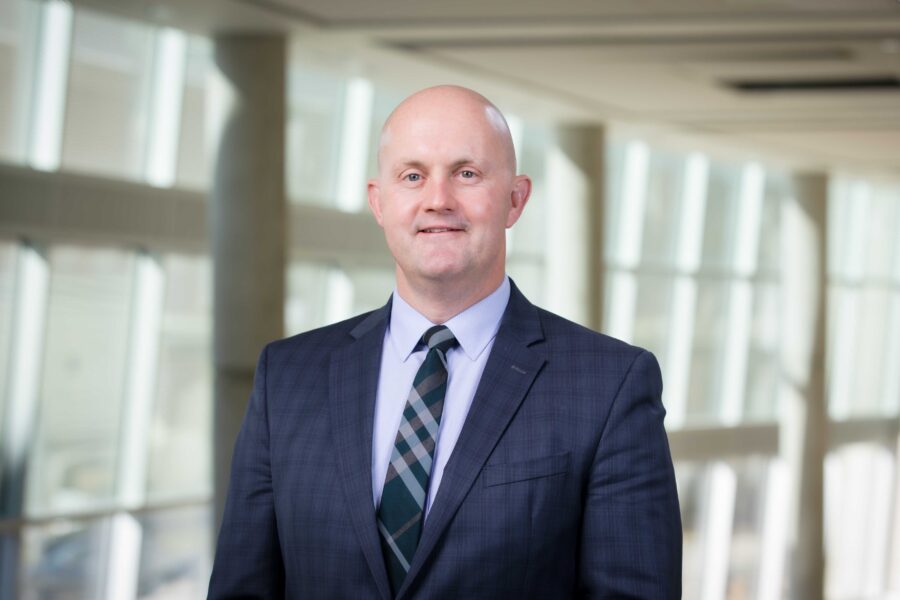Chad Vokoun, MD, chief of the University of Nebraska Medical Center Division of Hospital Medicine, said that on any given day at Nebraska Medicine’s main hospital, the Nebraska Medical Center, “we have upward of 60 patients waiting for placement.”
That means patients are “medically ready for discharge” from the hospital – but a major barrier, often outside clinician control, is contributing to a greater length of stay (LOS).
This can lead to inefficient use of resources, patient safety issues, provider and staff burnout, and a decrease in hospital capacity.
“Because those beds are occupied,” Dr. Vokoun said, “we have to turn patients away that we can possibly help.” Transfers from other hospitals are denied. Surgeries are delayed.
Research confirms it’s a nationwide problem. UNMC, and Dr. Vokoun, were part of a cross-sectional survey at 15 academic hospitals in fall 2022. The subsequent study, “Medically ready for discharge: A multisite ‘point-in-time’ assessment of hospitalized patients,” recently was published in the Journal of Hospital Medicine.
The study found that 35% of the 1,928 patients surveyed were medically ready for discharge. But almost 10% of the 1,928 were facing major discharge barriers. And of that 10%, a significant number of them had spent a month or longer in the hospital, technically medically ready for discharge, but unable to go home. This contributes to “hospital capacity strain.”
“Medically ready for discharge” means acute hospital‐level needs have resolved, and the patient is clinically considered an appropriate candidate to move to a lower level of care. Barriers to discharge might include requiring daily living support services or skilled therapy.
“It’s not any single challenge,” Dr. Vokoun said. “It’s across the board.”
Thus, long LOS.
The study confirmed previous research that shows a small percentage of patients, staying in hospitals for a long time, is having an outsized impact.
The study also found the disparity is significantly greater in public vs. private, and county vs. noncounty hospitals.
These hospitals tend to have the most medically complex patients, Dr. Vokoun said. And finding that next landing spot for them is difficult.
The study’s authors suggested “health systems, clinicians, patients, external health resources (e.g., skilled nursing facilities, home health agencies, etc.), communities, local and state governments, as well as payors,” should brainstorm solutions. “Initiatives should emphasize development of community or payor‐funded transitional care programs, targeted financial and structural changes that focus on the medically complex population, as well as strategic partnerships to remove bureaucratic, administrative, and legal delays.”
Dr. Vokoun agrees that a partnership with Douglas County Health Center has been crucial in placing some patients. Workforce development efforts today also could help someday down the road.
But, “I don’t pretend to have the solutions. Even if I had a magic wand, I don’t know where I would wave it,” Dr. Vokoun said.
“Just like the problem is multifaceted, the answer will be multifaceted.”
###
About UNMC
As Nebraska’s only public academic health science center, the University of Nebraska Medical Center enrolls more than 4,400 students across six colleges, two institutes and a graduate studies program. Its mission is to create a healthier future for Nebraskans through premier education, research and clinical care, but its impact –rooted in a culture of collaboration, big ideas and public-private partnerships – goes far beyond, in areas that include infectious diseases, rural health, cancer research and treatments, global health security, and simulation and experiential learning technologies.
About the Society of Hospital Medicine:
Representing the fastest-growing specialty in modern healthcare, the Society of Hospital Medicine (SHM) is the leading medical society for hospitalists and their patients. SHM is dedicated to promoting the highest quality care for all hospitalized patients and overall excellence in the practice of hospital medicine through quality improvement, education, advocacy, and research. Over the past decade, studies have shown that hospitalists can contribute to decreased patient lengths of stay, reductions in hospital costs and readmission rates, and increased patient satisfaction.
For more information about SHM and hospital medicine, visit hospitalmedicine.org.
About the Journal of Hospital Medicine:
The Journal of Hospital Medicine is the premier, ISI-indexed publication for the specialty of hospital medicine and official journal of the Society of Hospital Medicine. Published by Wiley, the journal advances excellence in hospital medicine as a defined specialty through the dissemination of research, evidence-based clinical care, and advocacy of safe, effective care for hospitalized patients.
For more information, visit journalofhospitalmedicine.com and follow the Journal of Hospital Medicine on X @JHospMedicine.
